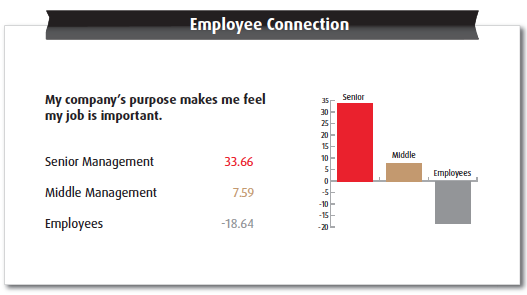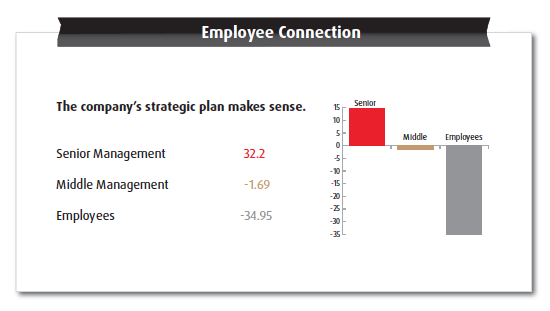Is Strategy the Job of Senior Leaders?
Conventional wisdom says it is. Heck, I kind of agree. This is why we pay people the big bucks, right? They have to make the tough strategic calls that make or break an organization. While that certainly makes sense, there seems to be a downside, given the research I just read done by Mike Tobias up at Mercanix, a very cool technology company in Toronto.
They took a look at how organizations’ strategies connect to their employees, from the senior team, through middle management, and down to the line employee. In looking at this research, I became somewhat concerned. It seems the senior folks–you know, the ones who get paid to develop those strategies–have become quite enamored with their strategic plans, but the actual employees of the companies seem woefully disconnected from it.
Check that out. The senior folks are mostly jazzed about their company purpose. Employees? Not so much (you’ll have to read the report to see their methodology; these scores are essentially in a “net promoter” format, which ranges from 100 to -100). This huge gap between employees and senior managers is a problem. And check out this. Do you think that employees actually understand the company’s strategic plan?
Nope. Even more than half the middle managers don’t get it. This is horrible. If we’re leaving the work of strategy up to the senior folks, then they are not doing their jobs because they have a whole army of employees who are completely disconnected from what they’ve cooked up.
Oh, by the way, the numbers change dramatically within the organizations that have metrics attached to their strategy. The research doesn’t even say what kind of metrics. Just ANY metrics, and the employees’ connection to the strategy jumps tremendously.
This research makes sense to me, given the prevalence of the machine approach in management today. Strategy is designed in the abstract, and implementation happens when people “do their job.” That won’t cut it any more. So sure, you can have your senior people develop strategy. I think it helps to have people who see the big picture and do that important work. But if they’re not smart enough to make strategy clear and alive in the work of everyone in the enterprise, then give them a generous severance package and find someone who can.



4 Comments
Chris Bailey
Jamie, this is interesting…and I agree that it’s not that surprising. But what happens if we work to make strategic thinking an organizational competency from top to bottom? What happens if we bring our front-line staff into the strategy discussions? Possibly even involve a diverse cross-section of our members? If an organization’s strategy is only developed at the executive level, what critical member data and insight is being missed and likely disregarded?
Passion and commitment are required to execute on any strategy. As you write, if there’s no buy-in throughout the organization, the strategy – no matter how good – is destined for failure.
Jamie Notter
Amen Chris! In Humanize we talk about what “Collaborative Strategy” really looks like. Nilofer Merchant’s The New How is a good resource on that as well. And glad to hear you’re coming back into the association space! I’ll be in Austin in late January if you want to get together.
Chris Bailey
Hi Jamie, I’ll fess up and say I really need to read your book 😉 I’ll also add Nilofer’s to the list. And let’s definitely plan on getting together and catching up when you’re in town. I’m really excited to be returning to the good work of associations.
Ouch! Employees don't get company strategies - ...
[…] Conventional wisdom says it is. Heck, I kind of agree. This is why we pay people the big bucks, right? They have to make the tough strategic calls that make or break an organization. While that cer… […]